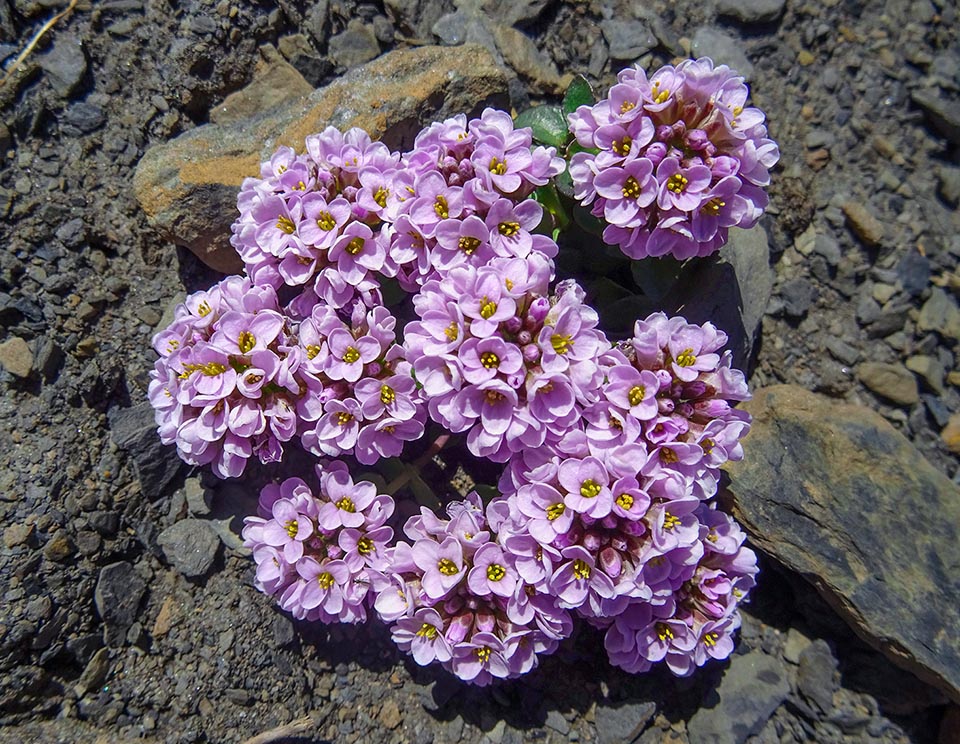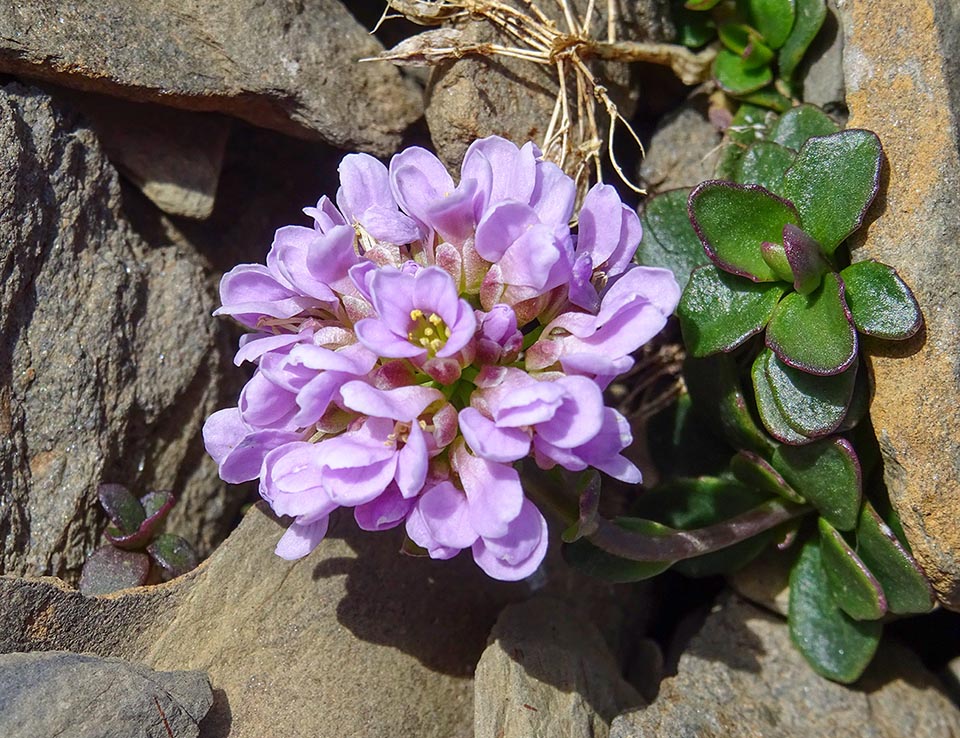Family : Brassicaceae

Text © Prof. Pietro Pavone

English translation by Mario Beltramini
Noccaea rotundifolia (L.) Moench is a species of the family Brassicaceae, tribe Coluteocarpeae, endemic to the alpine arc. It grows on rocky slopes, on stony rubble, on limestone. Vulgarly, it is known as Grass starling rotundifolia, Tlaspi with round leaves.
Noccaea is a genus dedicated to the Italian botanist, abbot, Domenico Nocca (1758-1841), director of the Botanical Gardens of Mantova and of Pavia and author, together with Giovanni Battista Balbis (1765-1831), of the Flora Ticinensis (1816). The specific term rotundifolia comes from “rotundus”, rounded and from “folium”, leaf, due to the rounded leaves. This species, in the past included in the genus Thlaspi [T. rotundifolium (L.) Gaudin], thanks to in-depth studies of molecular phylogenetics, is part now of the genus Noccaea.
It is a glabrous and glaucescent perennial plant with an herbaceous part that dries annually and a perennial woody part.
It has 5-8 (15) cm tall ascending stems, with stolons creeping between screes and rubbles and is usually found at altitudes between 1600 and 2800 m, at times up to 3379 m.

Endemic to alpine arc, Noccaea rotundifolia grows on rocky slopes, stony rubble and limestone at altitudes between 1600 and 2800 m, with a record of 3379 m © Olive Titus
The leaves are fleshy and glossy, the basal ones (4-9 x 18 mm), petiolate, arranged in rosette, spatulate 4-9 x 8-18 mm with one or two teeth per side. The cauline ones are sessile, oval-oblong, amplexicaul.
The flowers emit a delicate scent of honey and are supported by peduncles (5 mm) and arranged in dense racemose umbelliform, up to 15 cm tall, inflorescences. The sepals measure 2 mm, and the petals (2×5 mm) are pinkish-violet, rarely white. The anthers are oblong. The style measures 1,5-3 mm. Blooming begins in June and lasts until August.
The fruits are 3×7 (-12) mm silicles, with two lobes slightly rounded, with an up to 1,5 mm wing and 2-4 brown-greenish seeds per loculus. The dispersion of the seeds takes place in winter, done by the wind that pushes the plant on the snowy surface making the seeds release. The diploid chromosome number is 2n=14.
N. rotundifolia is characterized by a high morphological variability linked to the nature of the substratum and not to the geographical distribution.

The flowers, in bud June to August, are arranged in dense racemose umbelliform inflorescences releasing a delicate scent of honey © Olive Titus
As a matter of fact, the individuals living on limestone and calcareous schists present styles of reduced length, whilst those of the aeras with dolomitic limestones, prasinites, dolostones and serpentinites, present styles having a bigger length. This characteristic concurs with the modern systematic approach in which have been put in synonymy all the different varieties and subspecies previously mentioned.
This species can capture from the ground and accumulate internally nickel, lead, cadmium and especially zync. It is suitable to be utilized for the reclamation of soils slightly polluted by these metals, even if, due to the accumulation rates and the translocation factors, it cannot be considered as a hyper-accumulating plant.
Synonyms: Hutchinsia rotundifolia (L.) W.T. Aiton, Iberidella rotundifolia (L.) Hook.f., Iberis rotundifolia L., Noccaea rotundifolia subsp. grignensis F.K. Mey., Noccaea rotundifolia subsp. intermedia F.K. Mey., Thlaspi cepaeifolium subsp. grignense (F.K. Mey.) Greuter & Burdet, Thlaspi cepaeifolium subsp. rotundifolium (L.) Greuter & Burdet, Thlaspi grignense (F.K. Mey.) Landolt, Thlaspi rotundifolium (L.) Gaudin, Thlaspi rotundifolium subsp. grignense (F.K. Mey.) Greuter & Burdet
→ For general notions about BRASSICACEAE please click here.
→ To appreciate the biodiversity within the BRASSICACEAE family please click here.
